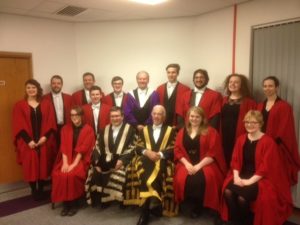During my secondary school education, I took part in a wide range of musical activities: musical theatre, orchestral playing and singing in the school choir. Later as an undergraduate this hobby was to provide a useful refuge from academia, singing as I did in various choral ensembles as well as student opera and musical theatre societies. Much of this was possible because the university I attended had a thriving music department, and undergraduates, postgraduates and lecturers were all involved in delivering opportunities for music-making.
When I came to Heriot-Watt to do my Ph.D. I expected no such opportunities, but looking back at the week I have just had I realise that I could not have been more wrong: I was involved in singing every day from Sunday to Friday. Despite the recommendation to “start at the very beginning” (from The Sound Of Music by Rogers and Hammerstein), in describing the different events I sang at I’m going to start at the end of the week, and work my way towards the beginning.
I was fortunate this year to be invited to be part of the 12-strong Graduation Choir, along with three other LINCS students: Hattie Cropper, Beth Hanley and Hugh Rose. Together we performed a processional and two songs, Mangwani M’pulele, an African children’s song and Burt Bacharach’s I Say a Little Prayer, at each of the six November graduations on Thursday and Friday.
Earlier in the week, the four of us were involved in an evening of music from Rogers and Hammerstein musicals, performed by Sinfonia Excelsior and Chorale Excelsior, the University’s orchestra and choir. A number of other LINCS students took part in the concert, and Hattie, herself one of the University’s Choral Scholars, sang one of the solo numbers. Also, last Sunday, those of us who sing in Excelsior per Cantum (the University Chamber Choir) represented Heriot-Watt University at Old College during a Remembrance Day Service held jointly by all four of Edinburgh’s universities.
These are not the only musical opportunities on offer at Heriot-Watt. For singers who favour popular artists and musicals, there is the HW Vocal Society, whose president is another LINCS student, Dan Green; and for more traditional repertoire, Juergen Munz, the SoSS Research and Knowledge Exchange Officer coordinates the HW Pipe Band. Information about these and other musical activities is available on the HWU website.
That HWU has such a thriving musical life is down both to the foresight of the University to appoint a Director of Music; and to the current long-standing incumbent of that post, Steve King. Steve splits his time between HWU and playing viola professionally with the Scottish Chamber Orchestra. He is a nationally renowned music educator and composer, and he brings a high level of musicality to his work within the University.
These opportunities, however, are not just about creating great music to a high standard. They are good fun, and provide a welcome break from academic study. They are a place where relationships are created between students studying in different schools and in different year groups; and between students and academic staff. The various groups forge links between the University and its local community. And they are an opportunity for students and staff to contribute to and make an impact on the broader life of the University in ways that can’t be measured by exam results, research outputs or budget lines.
So what next for the four singers from LINCS? Christmas is coming and with it the annual carol concerts, at Heriot-Watt University on Thursday 15th (this one is free) and at Rosslyn Chapel on Saturday 17th December. Tickets are going fast, so if you want to hear us in action, click on the links. We’ll look forward to seeing you there.
HWU Music: https://www.hw.ac.uk/student-life/campus-life/edinburgh/music.htm
Steve King: https://www.sco.org.uk/your-orchestra/who-s-who/135-steve-king
HWU concert tickets: https://www.eventbrite.co.uk/e/heriot-watt-christmas-carol-celebration-2016-tickets-29104331840
Roslyn Chapel concert tickets: http://www.rosslynchapel.com/event/carols-for-christmas-2/

